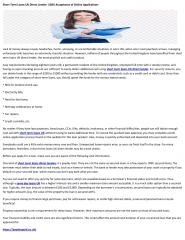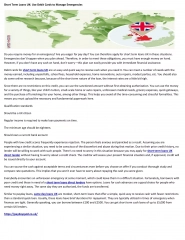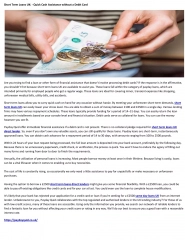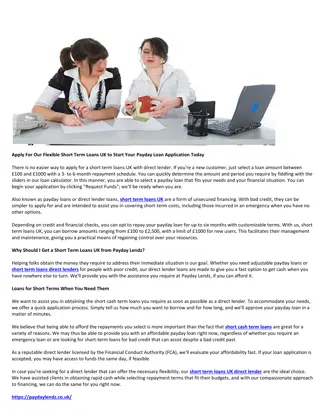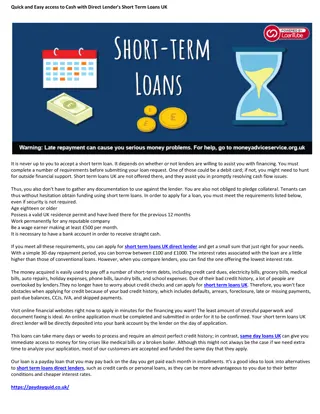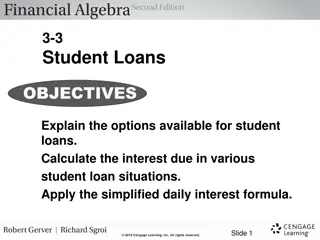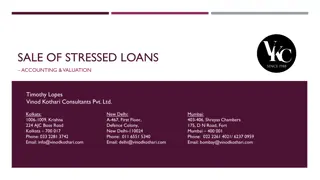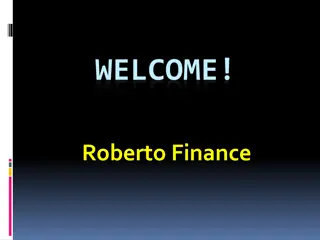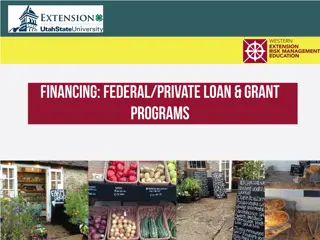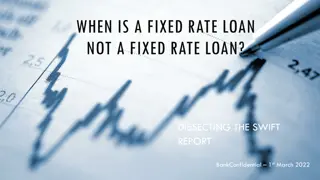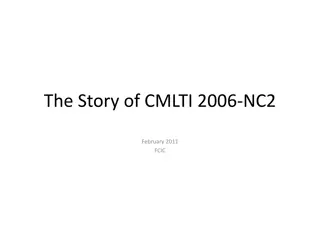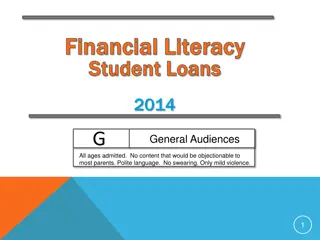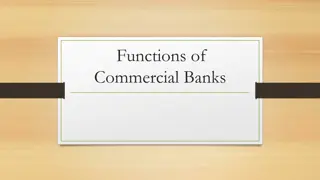Writing Off Loans
Best practices for handling loan write-offs efficiently and responsibly. Learn how to assess portfolios, adjust policies, communicate with borrowers, and ensure sustainability for your organization. Keep borrowers' needs in mind while managing risks and making tough decisions.
Download Presentation

Please find below an Image/Link to download the presentation.
The content on the website is provided AS IS for your information and personal use only. It may not be sold, licensed, or shared on other websites without obtaining consent from the author.If you encounter any issues during the download, it is possible that the publisher has removed the file from their server.
You are allowed to download the files provided on this website for personal or commercial use, subject to the condition that they are used lawfully. All files are the property of their respective owners.
The content on the website is provided AS IS for your information and personal use only. It may not be sold, licensed, or shared on other websites without obtaining consent from the author.
E N D
Presentation Transcript
Writing Off Loans Best Practices
Susan Brown, VP of Training, CAMEO Cat Howard, Senior VP of Programs, Community Vision Lea Salem, Chief Financial Officer, Community Vision Portfolio Assessment Default Policy Adjustment Loan Loss Reserve Analysis Capitalization Loss Strategies Write Off Procedures Accounting Steps Collections Options
Focus on Your Orgs Sustainability Be responsive to borrowers and assure your fund s sustainability Your organization is a community asset Not all borrowers are affected the same: Some borrowers suddenly have no revenue Some unaffected Some have increased revenue
Step One: Call Borrowers Ascertain their current and near-term revenue streams Problem solve with them. Who else do they owe? What is realistic? Never put borrowers who are communicating automatically into default with time can they pivot, restructure and survive? Staff debrief regularly to share info & forge a rolling strategy
Portfolio Assessment Based on borrower conversations: Review every loan Create a quick risk rating: High: Adversely affected within 3 months Medium: Adversely affected within 3-12 months Low: Unaffected or growing Determine reserve percentage based on these new ratings Adjust Loan Loss Reserves based on new ratings
Default Policy Adjustments After your loan-by-loan and aggregate portfolio assessment: 1. Can you provide grace periods, interest-only, deferments or extended terms that go beyond your standard policies to help borrowers and manage risk. 2. Do you need to adjust your delinquency and default policies? Do you need Economic Crisis policies?
Check Investor & State Guarantee Requirements Before you starting your default process, check investor and guarantor contracts: What are your funders requirements? What do your third-party guarantors allow and require re: modifications? Some guarantors require that you ve exhausted all your collections options before exercising your guarantee.
Project Losses 1. Project your losses, based on ratings 2. Project the amount your org might be writing off 3. Assess how your adjustments impact revenue 4. Review impact of revenue change on operations
Financial Analysis Once you have some idea of your losses: 1. Compare your Loan Loss Reserve to potential write off amount. Review as a total dollar amount and as ratio 2. Adjust LLR based on portfolio quality changes 3. Review your equity/debt capitalization ratio. Can you make your loan payments? 4. What are your first loss sources of capital? What funds will absorb the loss?
Making Decisions in Uncertainty 1. Create reports to capture all this information and analysis 2. Review with your management team, board and loan committees 3. Spend the time to get full understanding at all levels in your organization of the impact of anticipated write offs
Write-Off Procedures Review your closing documents and their default clauses Review your funders documents and contracts regarding write offs Confer with your counsel Create a memo to show you have followed all required procedures Notify investors and funders
Write-Off Procedures If default is occurring after conversations with borrower, notify client of legal notice of default including: The default rate of interest (if applicable; can waive) Curing period (often 30 days) an opportunity for compliance Collateral collection Report to credit bureaus
Accounting Steps Lending should be talking to accounting If applying the default rate, change accrual Segregate non-accruing loans Assess applicable fees Expense Bad Debt Change LLR based on revised portfolio quality and actual write offs Adjust payments to investors if possible
Write Off or Write Down? Write-off: The book value of an asset is declared to be 0 because there is no chance to recover any outstanding principal or interest. The loan is no longer an asset for the organization. Write-down: Lowers loan book value to what you believe you can recover. The loan remains as an asset on the balance sheet because it can be recovered in part. In either case, the loss enters the accounting system as an expense
Collections Review your policies and procedures on collateral collection. Adjust due to COVID crisis? Collecting makes it worse for clients and takes considerable staff time How will you collect and liquidate collateral? Determine if you can continue to collect any outstanding principal from borrower Forgiven principal is taxable
Managing a Big Hit Stay on top of hits to revenue and capital base due to write offs Strategize with board, funders and investors Re-cast organizational projections: best- and worst-case scenarios Develop strategies to compensate for lost capital and revenue
Lessons Learned Keep track of what you are learning from this economic downturn Take notes on changes you need to make to your standard policies, procedures and closing docs Does it make sense to create separate Economic Crisis policies? Does this crisis affect your organizational strategy, lending criteria or loan loss reserves policy, even post crisis?
As Information becomes available Visit our resource page: https://cameonetwork.org/coronavirus-resources- for-business Visit OFN s COVID-19 Community for sample docs/deferment letters: https://ofn.org/articles/new-covid-19-community-ofn-members-cdfi-connect SBA website for COVID Assistance for small business Lea Salem CFO for Community Vision can be contacted at: lsalem@communityvisionca.org Please contact Susan Brown with your requests for other CIVD-related webinars. sbrown@CAMEOnetwork.org.


